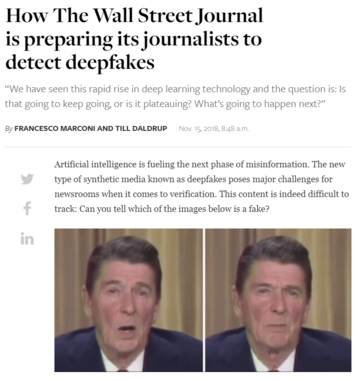The Wall Street Journal has launched an internal task force to fight “deepfakes”, fake videos made with artificial intelligence and machine learning technologies. They share some insights and tips. Most deepfakews are produced with faceswap technologies (that swap two faces). Other techniques use lyp sync, facial reenactment and motion transfer The best option to check if a footage is fake is often examining the source, as in traditional reporting. One can also try to find older versions of the footage with reverse image search engines, or examine it with video editing programs looking for glitches. Hints can be found also in the audio.
Thanks to new tools it is becoming easy for everyone to remove objects, change the weather, create artificial voice based on samples. As those technologies are becoming cheaper their diffusion will increase. They could be used to deceive news organizations (with the consequence of people losing trust in them), or to create deepfakes with journalists to attack them.
Tags: Fake news and disinformation Journalism education Fact-checkingThe content of this article can be used according to the terms of Creative Commons: Attribution-NonCommercial 4.0 International (CC BY-NC 4.0) . To do so use the the wording "this article was originally published on the Resource Centre on Media Freedom in Europe" including a direct active link to the original article page.


